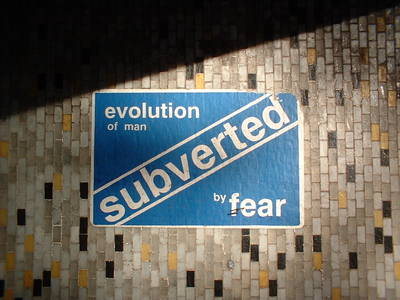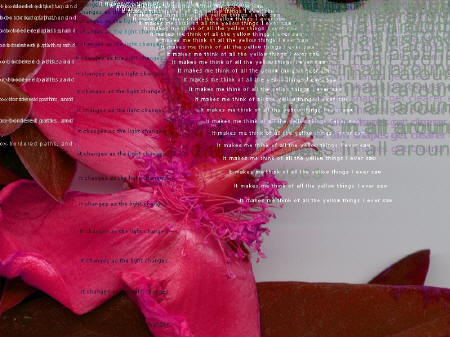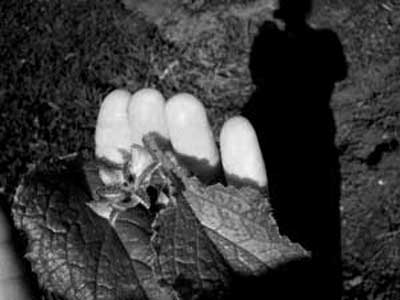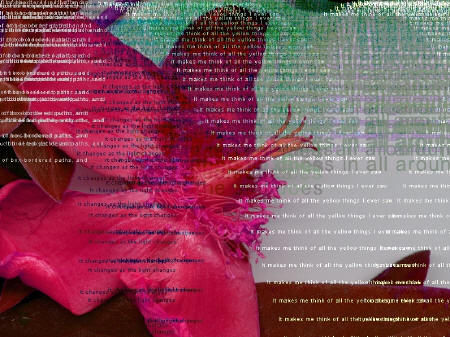|
|
| home | features | exhibitions | interviews | profiles | webprojects | gazetteer | links | archive | forum |
|
Distributed art of invisible networks: notes on network politics Magda Tyzlik-Carver
Art and politics are not two terms that would be linked through some form of representation. They are constituted as such in the same knot of the visible, the sayable and the thinkable, in the same framing of a common space where some practices appear to be named “arts” and some matters to be viewed of as “political”. Rancičre, 2002 Network art evolved from the early participation of artists in the growing telecommunication networks of the World Wide Web in the 90s, characterised by their limited accessibility and slow bandwidth. Internet art practices of the time were influenced by activist and hactivist (computer hacking + activism) approaches to the medium. The use of media as a tactical tool was defined in this way by Lovink and Garcia, two artists/activists/theorists engaged in practice of Electronic Civil Disobedience: Tactical Media are what happens when the cheap ‘do it yourself’ media, made possible by the revolution in consumer electronics and expanded forms of distribution (from public access cable to the internet) are exploited by groups and individuals who feel aggrieved by or excluded from the wider culture. (1997)
Network art follows also from relational art, which tried to re-establish the human bond in the changed social conditions of a globalised world. According to Nicolas Bourriaud (2002), who coined the term and explained the idea of Esthetic Relationell in his famous collection of essays, art practice of the 90s shifted the realm in which it operated from private, individual consumption of art to “intersubjective encounters” provided by art. Relational artists concentrated on production of “relations between people and the world, by way of aesthetic objects” (Bourriaud, 2002:42). They proposed models of sociality and distributed them in galleries or museums, which according to Bourriuad revitalise “the place of visuality in the exhibition protocol, without belittling it” (2002:43). Network art is also tied to the contemporary world of “post-material economies” (Terranova, 2006:30) defined through the concept of “immaterial labour”, which Terranova explains, following Lazzaratto, as “a political concept able to actively respond to the social transformation undergone by subjectivity in what have been called post-industrial, post-Fordist or network society” (Lazzarato, M. cited in Terranova 2006: 28). This new form of critical art today can be recognised by the fact that it takes place in many distributed locales, merging everyday activities taking place in “real life” with those which are enhanced by technology and Internet. Network art is a hybrid. It is a combination of sociality and technology, human relations mediated by internet based tools which allow communication, new and open models of participation and free and wide distribution, not only via telecommunication channels. It is art which uses network as its medium. This is the context in which I further discuss collaborative network art projects within which the connection between technology, sociality and mystery might suggest the possibility of reaching the ethical organisation of sensory experience that produces a politics of network aesthetics. This terminology derives from Jacques Rancičre who discusses the connection between politics, aesthetics and ethics in the context of distribution of the sensible in The Politics of Aesthetics (2006a). He characterises distribution of the sensible as the way in which forms of “what is visible and audible” and all that can be “said, thought, made or done” is categorised in the common. In the glossary of the terms available in the book, “distribution” refers to forms of inclusion and exclusion and the “sensible” is that which can be apprehended by the senses.
Glorious Ninth (www.gloriousninth.net) is a collaboration between new media artist Kate Southworth and sound artist Patrick Simons. Their collaboration started in the context of the net.art aesthetics with many works created particularly between 2001 and 2004. They are often interactive works which mix together text, visual and aural elements placed within the frame of a computer screen and within the context of Internet. love_potion (http://lovepotion.gloriousninth.net/) (pictures X3 above and below) is a distributed artwork by Glorious Ninth which has been developed since 2005 and it is defined by the artists as a “durational performance artwork in three phases” (love_potion a). It juxtaposes heterogeneous elements together such as growing borage plants from seeds, scents and magic spells, gardening tips on how to grow borage, DIY installations and sound and visual works created by Glorious Ninth which are freely available for download. And it is this conjunction that is arranged over time into three stages within or through which the quality of the public/audience/participants’ presence is subtly organised.
love_potion is a space and the time of the common. Everyone who performed the ritual shares the experience with the others regardless of the fact that they don’t know about each other. The common is established through ritual of going through each or at least one phase of love_potion, and realised through the very fact of its execution. The invisible network of tactical gardeners is the realisation, the object of the common that cannot be seen but can only be felt, experienced or imagined. Common is defined through shared habits in the community, the so called ethos which in love_potion exists in the activities of those following the prescribed steps in each of work’s phases. It is represented by dispersed (in time and space) rather then distributed actions of invisible network of people, repetitive activities turned into ritual, seeds and herbs, and audio-visuals, which all are organised by the mediative function of love_potion. It is this double mediation which turns the everyday chores into a work of art, a ritual, a performance and then takes them back again to the ‘real life’.
In love_potion by leaving open the moments in which to enter the work, the common is not instituted once and for all. The relation with the audience in this piece requires active engagement and agreement not only to participate in the work but also to allow love_potion to enter the life of the participant. That is perhaps a moment in which we are invited to open “our selves to a state of fragility and vulnerability” where “weaving together the processes and relations that co-emerge through growing ingredients, making potion and encountering others” (love_potion b) take place. Perhaps this is also where the sociality, the so called human bond or the common is being distributed in love_potion which if staged in the gallery as a performance is a mere representation of what it becomes when entwined in everyday activities of the performer. Invisible network of “tactical gardeners” intertwine processes and relations, online and offline, time and space. They negotiate for themselves life and art in each phase of the love_potion which they decide to stage or in which they participate. love_potion is at the same time the origin and the representation of what it creates. Representation here takes on different function, similar to that of consensus, which is to actively compose a common space to be reshaped by artistic practice. The clash between the actual experience of the ritual proposed by love_potion performed in the everyday, and non-experience represented by staging it in the gallery has the potential to create dissensus which plays out “the politics of works of art” (Rancičre, 2006a: 65).
Here, however, the common is established by another framework and produces something different to the invisible network of tactical gardeners. The participants in the sessions are virtually connected. Not only do they share the time which could be considered an immaterial node in this networked activity, but they are connected to the same server where text is stored. They are also “gathered” within a Skype window where discussions and conversations take place. Thus this network is organised by shared time and virtual space materialised by the visibility of participation in the session. What is also shared in this community is the physical distance of the majority of participants from each other. Here, the common exists by its defined temporality, physical dislocation and the virtual connectedness of its members.
Dislocation in case of Department of Reading sessions, and disconnection among the “tactical gardeners” in love_potion create the political space as it makes visible the in-between areas of the common. Rancičre says that: Politics plays itself out in the theatrical paradigm as the relationship between the stage and the audience, as meaning produced by the actor’s body, as games of proximity or distance. (2006a: 17) Transposing this statement into the network paradigm, the relationship is played out in the distance between the networks’ forms of organisation and how they are made visible. The lack of physical connection between the participants arguably makes the realisation of the common even stronger because it is not a representation of sociality such as is the case in many of relational artworks. Network art has the potential to embody the common where all the “realities” become visible. This is how the connection with ethics can be re-established in the contemporary art today, through the realisation of the common where “artistic practices are not ‘exceptions’ to other practices” (Rancičre, 2006a: 45) and where the common is not just an ethos but “polemical distribution of modes of being and ‘occupations’ in a space of possibilities” (Rancičre 2006a: 42).
References Bourriaud, Nicolas. 2002. Relational Aesthetics. France: Le press du reel Department of Reading. available at http://www.reading.department.cc/ [accessed 23 July 2007] Greene, Rachel. 2004. Internet Art. London: Thames&Hudson Kaprow, Alan. 1966. ‘Notes on the Elimination of the Audience’ in Assemblages, Environments, and Happenings. New York : Harry N. Abrams INC love_potion a. available at http://lovepotion.gloriousninth.net/index.html [accessed 23 July 2008] love_potion b. ‘Phase Three’. available at http://lovepotion.gloriousninth.net/phase_three.html [accessed 23 July 2008] Lovink, Geert and Garcia, David. 1997. ABC of Tactical Media. posted 16 May 1997 on Nettime and archived on http://www.nettime.org/Lists-Archives/nettime-l-9705/msg00096.html [accessed 22 February 2007] Rancičre, Jacques. 2002. Aesthetics and Politics: rethinking the link. [talk] Berkley: Berkley University. September, 2002. available at: http://www.16beavergroup.org/monday/archives/001881.php [accessed 10 April 2007] Rancičre, Jacques. 2006a. The Politics of Aesthetics. Continuum: London, New York Rancičre, Jacques. 2006b. The Politics of Aesthetics. Text available on http://www.16beavergroup.org/mtarchive/archives/001877.php [accessed 10 April 2007] Southworth, Kate. 2007. love_potion from glorious ninth. posted 19 February 2007 on Rhizome and archived on http://rhizome.org/discuss/view/24718#46717 [accessed 12 March 2007] Terranova, Tiziana. 2006. ’Of Sense and Sensibility: Immaterial Labour in Open Systems’ in Joasia Krysa [ed] Databrowser 03: Curating Immateriality: The Work of the Curator in the Age of Network Systems. New York: Autonomedia
First published by Techsty Magazine 5 (2008) (www.techsty.art.pl) |
|
|

 Early
Internet art of the 90s manifested itself in the net.art works of such
artists as Heath Bunting (UK-picture right), Olia Liliana (Russia), and Vuk Cosic
(Slovenia), and in the offline environment of festivals and conferences
such as Next 5 Minutes or Ars Electronica, mailing lists and online art
communities such as nettime, THE THING, Syndicate, Rhizome.org, etc.
(Greene 2004).
Early
Internet art of the 90s manifested itself in the net.art works of such
artists as Heath Bunting (UK-picture right), Olia Liliana (Russia), and Vuk Cosic
(Slovenia), and in the offline environment of festivals and conferences
such as Next 5 Minutes or Ars Electronica, mailing lists and online art
communities such as nettime, THE THING, Syndicate, Rhizome.org, etc.
(Greene 2004). 
 In its formative structure
love_potion could be considered a distributed, networked
happening. All the elements needed for performing love_potion are
given on the site and we are invited to “join the invisible network of
tactical gardeners” (Southworth 2007). This invitation is where the
complexity of this work is articulated. It negotiates many levels of
engagement by placing heterogeneous elements in the mysterious
relations expressed through metaphors which I will explore. My reading
is that the “invisible network” can be understood as the common;
“tactical gardeners” are the audience/people/participants and magic
potion could be read as participation. If we follow this kind of poetic
reading of love_potion this piece then becomes a ritual of
participation in the performance. Through its distributed nature it
manages to eliminate the audience as called for by Allan Kaprow (1966),
and creates participants who “have a clear idea of what they are to do”
and also are “willing and committed” declared in their decision to
perform love_potion. They are the tactical gardeners who plant
the borage and when it is ready use it in preparing the magic drink and
with frankincense cleanse the space chosen for the performance. The
heterogeneous elements here are put together to strengthen the
“potential for invisible network of love to co-emerge” (love_potion
a).
In its formative structure
love_potion could be considered a distributed, networked
happening. All the elements needed for performing love_potion are
given on the site and we are invited to “join the invisible network of
tactical gardeners” (Southworth 2007). This invitation is where the
complexity of this work is articulated. It negotiates many levels of
engagement by placing heterogeneous elements in the mysterious
relations expressed through metaphors which I will explore. My reading
is that the “invisible network” can be understood as the common;
“tactical gardeners” are the audience/people/participants and magic
potion could be read as participation. If we follow this kind of poetic
reading of love_potion this piece then becomes a ritual of
participation in the performance. Through its distributed nature it
manages to eliminate the audience as called for by Allan Kaprow (1966),
and creates participants who “have a clear idea of what they are to do”
and also are “willing and committed” declared in their decision to
perform love_potion. They are the tactical gardeners who plant
the borage and when it is ready use it in preparing the magic drink and
with frankincense cleanse the space chosen for the performance. The
heterogeneous elements here are put together to strengthen the
“potential for invisible network of love to co-emerge” (love_potion
a).
